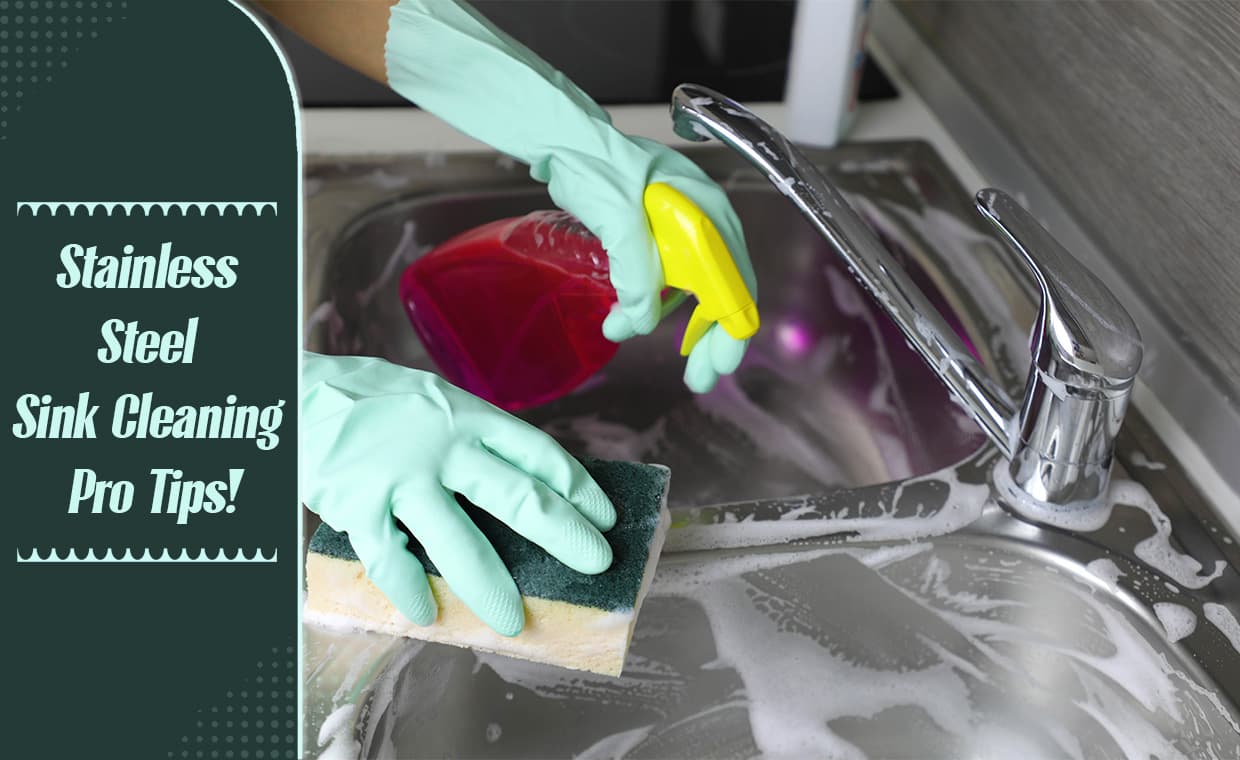
The sink is the centre of the kitchen, so it must be kept clean. Sinks could be made of various materials, including stainless steel, granite, quartz, etc. However, if you have a stainless-steel sink, you must be more concerned about keeping it clean as it is prone to noticeable stains. Here, at Gharpedia, you can learn how to remove stains from stainless steel sink, know about a couple of stainless steel sink cleaners, how to clean sink stains and how to clean a steel sink etc.
What Causes the Stains?
The corrosion-resistant stainless-steel surface is made from the natural chromium oxide film found on all surfaces of this type, particularly those in prolonged contact with air due to its oxidation tendency (rusting).
Over time, these protective coatings deteriorate, allowing stains to set in. In addition, it may result in more severe problems like corrosion, where water might re-enter and cause more harm.
How to Remove Stains from a Stainless Steel Sink?

Although stainless steel is an excellent material for kitchen sinks, cleaning a stainless steel sink becomes a headache if it develops stains. Chemicals may be eliminated with low-cost items, making your sink even more appealing. The type of stain will dictate the technique required to remove it from your sink.
The Collection of Queries about Cleaning Stainless Steel Sinks is Provided Below:
- How to Remove Acid Stains from Steel?
- How to Clean Stainless Steel Sink Stains of Bleach And Chlorine?
- How to Remove Bleach and Chlorine Stains?
- How to Remove Rust from Stainless Steel Sink?
- How to Clean Stainless Steel Sink Hard Water Stains?
- How to Remove Chemical Stains from Stainless Steel Sink?
- How to Prevent Stains on Stainless Steel Sink?
- What is The Best Way to Clean Stainless Steel Sink?
- How to Clean Stainless Steel Sink?
01. How to Remove Acid Stains From Steel?

Strong acids with a pH lower than 1.0 should be avoided to keep your stainless steel from corroding because they are generally corrosive to the metal and can damage it over time, even when used with caution. The powerful solutions used to remove acid stains from stainless steel kitchen sink require the use of protective gloves to avoid skin damage.
Proceed with the steps below with a stainless steel sink cleaner.
Step 1: The stained area should be rinsed with water. Spray bottles can be used to treat vertical surfaces.
Step 2: Next, mix equal parts water and baking soda before pressing it onto the discoloration (the paste will stick better when mixed this way).
Step 3: Just leave the paste on the stain for a while.
Step 4: Wipe it off with a damp towel.
Step 5: If the stain doesn’t change colour, use ammonia, which is also a stainless-steel sink cleaner.
To remove acid stains, just mix ammonia and water in a 1:1 ratio.
Step 6: After getting rid of the stains, thoroughly rinse your sink with water. Next, wipe out any remaining chemicals using a soft cloth. Then, dry your sink with a paper towel or soft cloth.
How to Clean Stainless Steel Sink Stains of Bleach and Chlorine?

One of the chemicals that has the potential to corrode stainless steel is chlorine. If you spill bleach on your sink, it will turn dark brown or grey due to the presence of multiple different chemicals and leave behind an irrevocable stain as proof for years because they share so many chemical similarities.
For example, short-term contact with salt water or chlorine bleach should not raise any red flags. But, if the exposure continues, the discolouration can become permanent. However, such stains can be removed using a stainless steel sink cleaner like baking soda.
Follow the below-mentioned steps to clean the stainless-steel sink with stainless sink cleaner:
Step 1: A paste can be made by mixing baking soda with water in a 1:1 ratio.
Step 2: Use the paste on any visible stains.
Step 3: Give the paste 10 to 15 minutes to set on the stain.
Step 4: Use a damp towel to remove the paste.
Step 5: Now follow this up with vinegar. The acidic nature of vinegar will cause the dissolution of the stains without damaging your sink. However, be cautious enough not to let too much of the acidic solution drop down inside, as this can cause damage over time.
Step 6: For around 20 minutes, let all the ingredients rest.
Step 7: Remove any substances by wiping them clean.
How to Remove Rust from Stainless Steel Sink?

Iron stains can appear on stainless steel sinks when people wipe the sinks with steel wool. This is because the amount of chromium on the surface may decrease as small iron particles are left behind. The steel will rest if the chromium content is less than 10%. On the other hand, the chromium oxide layer can regenerate and repair itself after the iron pieces and the rest have been removed However, when the rust stains are stubborn, the only question that will bother us is how to remove stains from a stainless-steel sink. For cleaning a stainless steel sink, follow any one of the below two methods.
Method – 1: How to Get Rust Stains out of Stainless Steel Sink

Step 1: Mix 1 cup of washing detergent with 2 tablespoons vinegar. This is the best cleaner for stainless steel sink.
Step 2: Add enough hot water to produce a paste, but not so much that it runs all over the place or is so runny that it won’t stick properly to the stains; use paper towels instead if none are available.
Step 3: Once combined, thoroughly apply the paste over the stain and leave it to settle for about an hour.
Step 4: If the paste works as intended, the rust should disappear after being wiped away. Otherwise, try these steps again.
Step 5: To get rid of all the little pieces of metal that contributed to the rust, thoroughly rinse and clean the sink now.
Method – 2: How to Get Rust Stains out of Stainless Steel Sink

Step 1. Create a paste by combining one tablespoon of baking soda with two cups of warm water in a mixing bowl.
Step 2. Scrub the area gently with the paste and a soft brush to remove the rust.
Step 3. Once the stains are gone, rinse it off. The baking soda should be washed with warm water.
Step 4. Once the sink has dried, you can either rinse it thoroughly or wipe it down.
By trying these steps, you will definitely get rid of rust stains from your sink. If you wish to know how to remove rust stains from tiles, you must have a look at our blog.
How to Clean Stainless Steel Sink Hard Water Stains?

Without a water softener, your sink’s surface could deteriorate over time due to mineral build-up. Rust stains can be caused by dissolved iron, while cloudiness on the steel’s surface might be caused by calcium deposits.
Follow the steps mentioned below and get an answer to how to remove hard water stains from stainless steel sink
Step 1: Make a paste by mixing baking soda with water in a 1:1 ratio.
Step 2: After putting the paste on the stain, let it sit for 10 minutes.
Step 3: Then, wipe away the residue with a damp cloth before rinsing the sink with hot running water and vinegar.
How to Remove Chemical Stains from Stainless Steel Sink?
Method – 1 How to Remove Chemical Stains from Stainless Steel Sink by Vapor Cleansing Process

- A kettle, spout, and paper towel are all you need to get rid of light chemical stains.
- To get started, get a paper towel and a kettle of hot water in the first place. After that, pour hot water into the sink and cover the stain with a paper towel.
- To make the cloth moist, pour the extra hot water over it.
- Wait 5 to 10 minutes after pouring water to allow the surface of the sink to cool.
- The last step is to remove any remaining stains from the sink with a dry paper towel before rinsing the sink with clean water.
Method – 2 How to Remove Chemical Stains from Stainless Steel Sink by Baking Soda and Liquid Dish Soap

If the previous method does not remove all of the stains, you will need to make a baking soda solution.
Following is the best way to clean stainless steel sink:
Step 1: Mix baking soda and liquid dish soap together to form a paste. Use an equal amount of each ingredient, and if necessary, add additional water to form a smooth paste.
Step 2: Dab the paste with an old toothbrush.
Step 3: Scrub the stain gently.
Step 4: If you are happy with the outcomes, get some warm water and rinse the paste away.
Step 5: After that, wipe the surface of your sink with a paper towel.
How to Prevent Stains on Stainless Steel Sink?

Below are a few ways to prevent stains on stainless steel sink.
1. Rinse your sink after each use: Soap dishes contain chlorides and, rinsing them helps to avoid the appearance of water spots and corrosion.
2. Scrub in the direction of the grain: This will help to blend your sink’s surface texture.
3. Avoid abrasive cleaners: To protect your stainless-steel sink’s finish, never use harsh chemicals or abrasive cleansers. These cleansers have the potential to discolour and even ruin your sink.
4. Make use of bleach-free products: Bleach has the potential to discolour your stainless-steel sink. As a result, you must avoid using any bleach-containing cleaning product to clean your sink. But if bleach gets into your sink, clean it right away with a lot of water.
5. Dry Thoroughly: Finally, washing off and drying the surface of your stainless-steel sink is essential to avoid water spots or rusting over time. For the greatest results, make sure your dry towel is clean and free of old oil.
Conclusion
Sinks made of stainless steel are prone to several stains. So, before selecting how to remove the stains, you must first identify the type of stain. This is due to the fact that various stains require different removal methods.
Now that you know how to remove stains from stainless steel sinks, you must also take a look at our blog on how to fix a leaky sink trap.
How to Fix a Leaky Sink Trap in Kitchen? | Basic Guide For You!
Author Bio
Fathima Israr –































